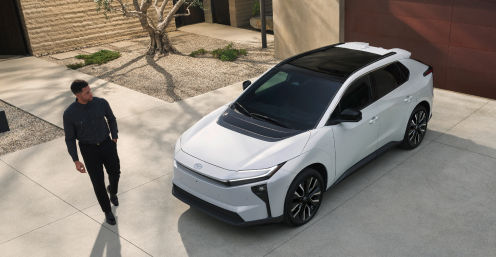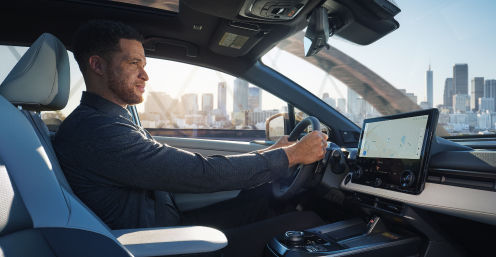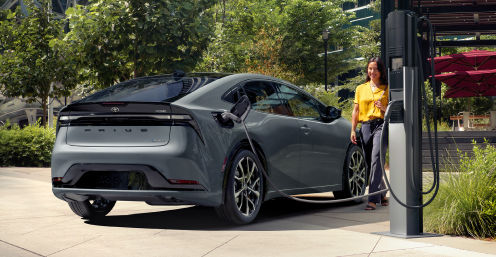Select a province & language
Entrance to this website assumes you have read and agree to these Legal Terms and Conditions and the Privacy Policy.
Entrance to this website assumes you have read and agree to these Legal Terms and Conditions and the Privacy Policy.

Charging a Battery Electric Vehicle (BEV) or Plug-in Hybrid Electric Vehicle (PHEV) is simple. Just plug it in. At home, at work, or at any public charging station. Electric Vehicle (EV) charging times will vary depending on whether you are using Level 1, 2 or 3 EV charging.

Charging an electric vehicle has never been simpler or more convenient. And not only are there more places to charge an EV than ever before, but there are also more charging options as well.

You can charge a Battery Electric Vehicle (BEV) or Plug-in Hybrid Electric Vehicle (PHEV) at home, at work, or at most public charging stations. How long it takes to charge an electric vehicle depends on the size of the battery and the speed or Level of charging point.
Level 1 charging is the simplest option, and it charges slowly. On the plus side, it uses power from standard wall outlets in homes. All Toyota BEVs from 2026 and beyond include a dual-voltage charging cable to facilitate Level 1 charging.
Level 2 is like Level 1, but with twice the voltage and increased amperage. This means vehicles charge much faster. At home, this requires installing a Level 2 charger into higher voltage electrical outlets1 – like those that power large appliances like clothes dryers or ovens. In public, Level 2 is widely available at public stations.
DCFC (Direct Current Fast Charging) provides even higher voltage in the form of DC power. Level 3 requires the use of specialized equipment and manufacturer-specific plugs, which are not available in residential homes. Charging time will vary widely depending on weather conditions and other factors2.
Most EVs use a standard SAE J1772 connector, which combines AC and DC inlets for charging at Level 1 or 2. This offers driver three options for charging at home.

Toyota’s incorporation of the North American Charging System (NACS) port on certain vehicles offers convenient charging access to over 5000 public charging stations across Canada. And finding public charger is easy! Simply use the Toyota App and in-car navigation to help you find the nearest charger. And should you ever run out of charge, Toyota Roadside Assistance can tow you to the nearest charging station so you can get back on the road.

With the NACS Charging Adapter, Toyota BEV owners now have access to a rapidly expanding NACS DC Fast-Charging network that includes IONNA Rechargeries and Tesla Supercharger sites, adding thousands of convenient locations for quick, reliable charging. This expanded access makes planning both daily commutes and road trips easier than ever. (For Toyota battery electric vehicles only. 2025 and earlier BEV models require adapter for use.)

The NACS Charging Adapter allows compatible Toyota BEV owners to access thousands of Tesla Supercharger sites locations, expanding available DC fast charging options beyond public networks.
The adapter is designed exclusively for 2025 and earlier Toyota BEV models.
As a Toyota BEV owner, access to a more extensive charging network provides added convenience and peace of mind.
No. The NACS Charging Adapter is not compatible with Toyota plug-in hybrid electric vehicles (PHEVs).
There are a few different kinds of connectors to charge your EV.
For illustrative purposes only. Connectors not shown to scale.
It's also best to avoid charging from 0% to 100% regularly and to keep the battery in a moderate charge range (10%-80%) for optimal longevity.
After three 10-80% charge sessions, DC Fast Charging over the next 24 hour period may take longer and be less effective. Starting with 2026 model BEVS, this limit increases to five charging sessions per day.
Battery preconditioning lets you bring your BEVs battery to an optimal temperature for DC fast charging in cold weather, improving charging speeds.
Charging times for your EV will depend on many factors including the kind of vehicle you have, the temperature, and the kind of charger you are using. For example, a 2026 bZ connected to a Level 3 charger can go from 10 % (Low Battery Light) to 80% in as quickly as 28 minutes3.
With over 5000 public charging stations across Canada, getting a charge on the go should be no problem. Simply use the Toyota App plus your vehicle’s nav system to find the closest charger.
Like all Lithium-Ion batteries, there will be some reduction in capacity over the life of the battery. For peace of mind, Toyota EVs have an EV Component Warranty of 8 years/160,000 kms.
For longer trips, charging your vehicle fully, and then determining where charging stations along your route will allow you to recharge. Once you know that, plan your route, and timing, accordingly.

BEVs and PHEVs are growing in popularity, as are the options for vehicles and locations to charge them. Toyota’s adoption of the NACS charger means more charging options than ever for drivers, and those options will continue to grow. In fact, access to NACS supercharger is expected to grow from 5000 locations to over 30,000 by 2030.


